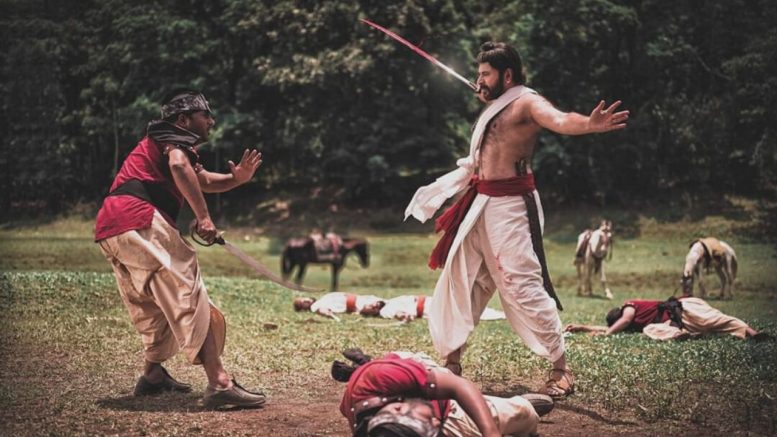Padmakumar’s film opens right away with the penultimate Mamangam, a duodecennial medieval fair held on the banks of Bharathapuzha where the Chaverukal plots to avenge and overthrow the Zamorin ruler. Chandroth Valiya Panicker (Mammootty) is introduced in a well-cut shot that you’ll never anticipate coming. This is what Shankar Ramakrishnan (credited as adapted screenplay) and Padmakumar tries to conceive throughout the film. Mamangam bids adieu to many cliches one would look forth from a history-drama starring Mammootty. It manifests through a masala movie template.
But Mamangam works as an interesting antithesis to a masala movie. An item number that is largely associated is replaced with the Mookuthi art form which was later subsumed into the desi Mohiniyattam, the action sequences becomes a cultural lexicon as a displayal of the omnipresent Kalaripayattu, it’s OTTness too has right reasons to put forth, the central masala conceit is the pivotal content itself – The Mamangam festival. Mamangam transcends the period drama genre constraints to an intact portrayal of history. It takes every cinematic liberty for granted, without diluting the core. Aside of these, Mamangam also subverts clichés of many sorts.
M. Jayachandran’s Musical Brilliance: Enhancing the Artistic Value of Mamangam
In Pazhassiraja, MT Vasudevan Nair tweaks history that was rooted in folk tales with his own interpretation. Pazhassi was given a hero avatar. Shankar Ramakrishnan who’s credited for the adapted screenplay (story by Sajeev Pillai) fills the voids in folklore quite beautifully. The first look poster placed Mammootty in the centre with fellow warriors Chandroth Panicker (Unni Mukundan) and Chandrunni Menon (Achuthan), we might warm up for a climax action Showdown in which Mammootty takes the lead. But the promo is tweaked. Shankar writes a third act. With this, Mamangam is even more effective. Adding the fact that Padmakumar smartly opens the movie with the most fiercy Mamangam ever happened in history. Even though the action isn’t extraordinary, this makes us to impose what to anticipate from in climax showdown (which probably is the last Mamangam).
Moreover, it also fills the voids of history. Because as Ranjith’s voiceovers refer, there is not the mention of this warrior who brought bodies of died Chaverukal to Valluvanadu back. Ramakrishnan’s screenplay smartly manages to attach a post-climax action. But the only drawback, which not just here, but through and through Mamangam is Padmakumar’s inability to soak this grandiose into screen. The action (directed by Shyam Kaushal) becomes tad boring.
“Shankar Ramakrishnan’s Narrative Mastery in Mamangam
Ramakrishnan’s previous historical film Urumi, was about the contemporary reflection of history. Mamangam too does the same on a hindsight. The central theme is about the futility of violence and revenge, the pointless acts that meets with tragic repercussions and contemporary lingering of the same The repercussions has a masala rooting well set up by M Jayachandran’s beautiful lullaby song sung by Bombay Jayasree. But Unni Mukundan’s love track was disarranged and has no solid root.
One of the solid things that enhanced the artistic value of Mamangam was M. Jayachandran’s superb musical work. Especially, Mookuthi sung by Shreya Ghoshal is extremely pleasing composition which grew on me after many listens. It was so nicely cut as bits by editor Raja Mohammed. Mamangam is narrated with Rashomon, The murder of a Zamorin merchant.
Cultural Lexicon and Historical Nuances: The Intricacies of Mamangam
Amidst it there is a juxtaposition of Mammootty’s feminine avatar. A man who is often worshiped as masculine personification in Kerala. Mammootty manages to get passed this character without making a caricature out of himself. He also gives sold emotional wreckages. Specifically in the scene where Iniya’s character raves and adores about the brilliant warrior who fought for the last Mamangam, Mammootty’s eyes filled with tears and performs a terrific underplay. This continues in the scene where Chandrunni Menon talks about his maternal uncle. Later, in a major transformation, Mammootty’s dialogue rendition becomes a source of goosebumps by its own. Seasons pass, decades pass, he is still at the top of the game. Hands down.
Unni Mukundan was a major let down along with every other major casting choices done by the makers, excluding Master Achuthan and Prachi Telhan. Most of the casting is terrible for a film of the stature like Mamangam. For Unni’s roles a young actor who has potent face value must have been roped. Because, he makes screen presence shallow. Prachi was an intact cast as Unnimaya, she at least tried to convey many emotions unspoken. Siddhiq’s introduction sequence was pure gold. But his dialogue delivery at times felt shoddy.
Mamangam: A Masala Movie Beyond Clichés
Mamangam in a nutshell, is not an action fiesta as you may think. It’s a rather earnest recreation of history with every nuances, where Mammootty taking a backseat. There are also obvious nods to Pazhassiraja. Manoj Pillai’s cinematography specifically tries to embody this homage.

CA Student who’s enthusiastic about films.


Be the first to comment on "Mamangam (review)"